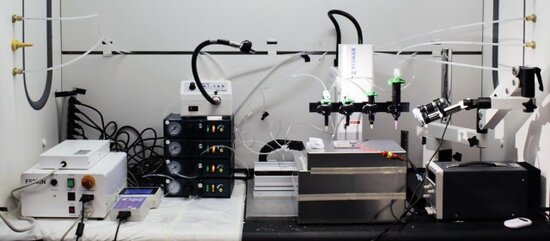Princeton: The first fully 3D printed quantum dot LED
It seems like everything is being 3D printed nowadays. From human body parts and electronics, to toys. If you have followed the industry over the last years, you have likely heard about 3D-printed LEDs. Although an entire LED had not been 3D printed, researchers had been working on numerous possible ways of doing so.

Five different materials of the LED
When you think of 3D printer, something like the MakerBot probably comes to your mind - another gimmick that can build physical objects out of plastic, or sometimes metal if you’re lucky. However, many scientists are interested in utilizing the principles of 3D printing and additive manufacturing to construct small electronic devices completely from scratch, such as the a new type of LED built by researchers at Princeton University. Using a custom 3D printer, this team was able to fabricate quantum dot LEDs composed of five different materials. As the team leader Michael McAlpine says, this is the first time anyone has accomplished such a task.
Development of the special 3D printer
The first step in making these LEDs was to build the printer necessary to do it (no off-the-shelf printer was going to do the job). It took more than six months and $20,000 to get this far, and no one knew if it would be possible to combine the necessary materials, even with this custom equipment. When all was said and done, the team found their LED printer to be completely functional, unlike some past attempts that could only print a circuit breadboard onto which pre-made LEDs were attached.

Layers of quantum dot LEDs
The bottom layer of each quantum dot LED is composed of silver nanoparticles, which are perfect for connecting the LED to an electronic circuit. On top of that are two polymer layers that push electrical current up toward the next layer. This is where the real “quantum dots” are — they’re nanoscale semiconductor crystals, in this case cadmium selenide nanoparticles wrapped in a zinc sulfide shell. Each time an electron hits these nanoparticles, they emit orange or green light. The color can be controlled by changing the size of the particles. The top layer is a comparatively ordinary gallium indium that directs the electrons away from the LED.
How the 3D printer works
The 3D printer works in a similar fashion to 3D printers that rely on plastic, but on a much smaller scale. It lays down a single layer of the LED, then moves up to add the next one composed of a different material. When the five-layer stack is complete, it’s a functional quantum dot LED. Quantum dot LEDs are in some ways quite similar to the LEDs used in current smartphones and lightbulbs, but again, smaller. This is why many electronics firms are looking toward quantum dots as the future of display technology.

A low-res picture of a working 3D-printed quantum dot LED
If you’re looking for a current analog of quantum dots, it’d be AMOLED. A quantum dot screen only uses power when displaying a color, and can shut unneeded pixels completely off. The difference, however, is that a quantum dot LED can display a wide range of colors without the degradation or vulnerability to humidity and oxidation of LEDs and AMOLEDs. The problem has always been how to go about making these tiny LEDs, but the 3D printer build at Princeton seems rather capable for a first try.
In addition to printing the quantum dot LEDs on a flat surface, the team succeeded in building then onto a convex surface (like a contact lens) and even created a 3D cube of quantum dot LEDs with all the electronics and light emitting components built in. Hey, it is a 3D printer after all. The team found the performance of the LEDs to be above average, but not quite as good as industry-leading components made via traditional processes. Still not bad for the first fully 3D printed LEDs ☺
Zdroje:
- http://3dprint.com/23084/3d-printed-quantum-dot-leds/
- http://www.extremetech.com/extreme/193583-princeton-creates-a-custom-3d-printer-that-prints-quantum-dot-leds-from-scratch
